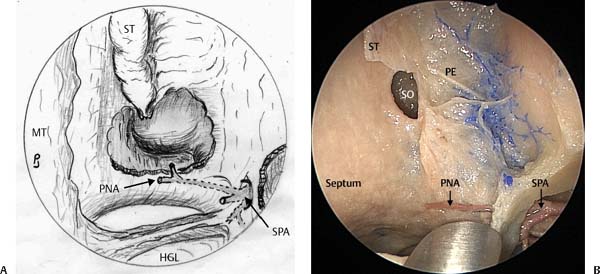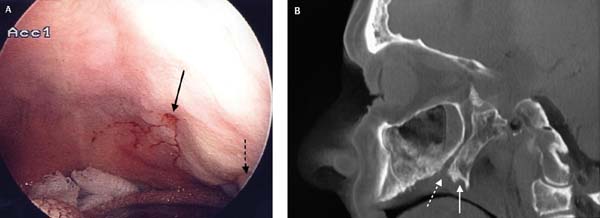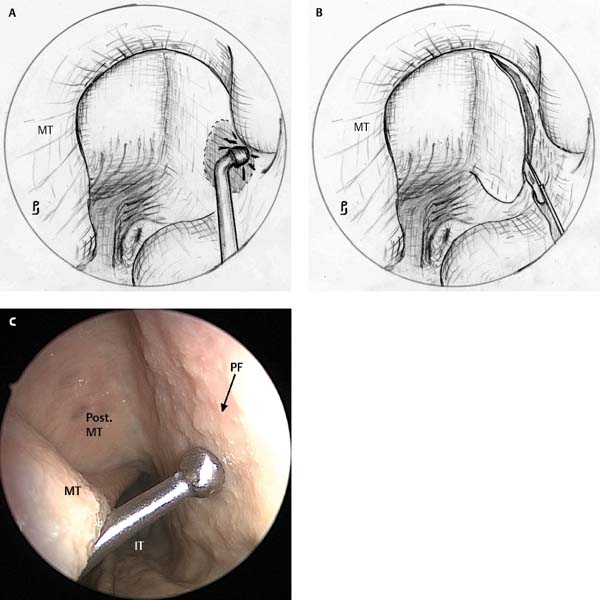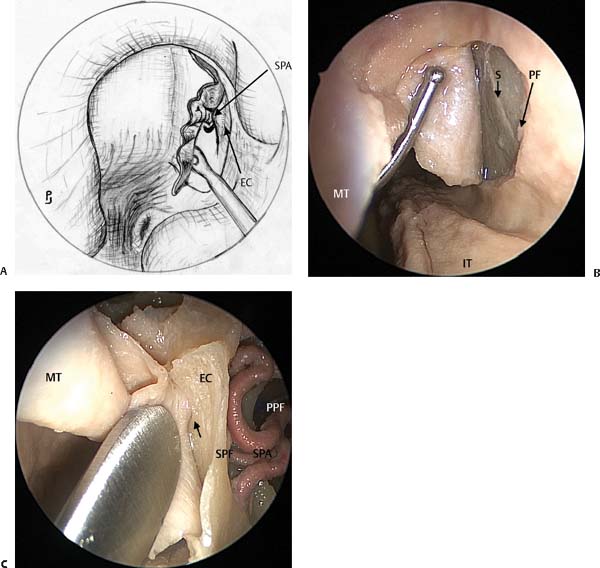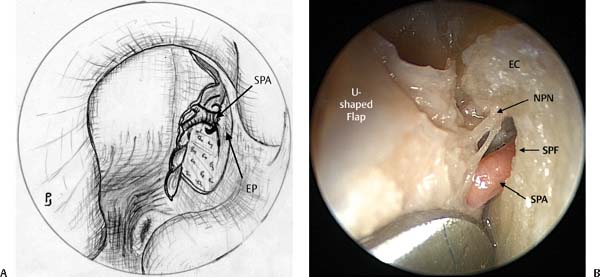10 Epistaxis may be classified clinically into anterior and posterior bleeds.1 If the vascular supply of the nose is reviewed, it is apparent that anterior epistaxis would originate from the vascular anastomosis of vessels around Little’s (or Kiesselbach’s) area or from the anterior ethmoidal artery. Little’s plexus is formed by branches from the sphenopalatine artery (SPA; via the posterior nasal artery branch) anastomosing with branches from the greater palatine, nasolabial (a branch of the facial artery), and anterior ethmoidal arteries. Bleeding from Little’s area is usually easily visible and managed by either local cautery or an anterior nasal pack. Bleeding from the anterior ethmoidal artery is rarely spontaneous and usually seen after trauma with associated skull base fractures or intraoperative injury. Posterior bleeding is often seen from under the inferior turbinate where branches of the SPA anastomose with branches from the pharyngeal artery. This area is termed Woodruff’s area. Bleeders in this region can be difficult to visualize due to their location under the posterior end of the inferior turbinate. Other posterior bleeders may arise from the lateral nasal wall, posterior choana, or posterior septum. Significant postoperative epistaxis (as opposed to the bloodstained ooze usually seen in the first 24 hours after nasal surgery) typically occurs when a vessel of significant diameter bleeds. Logically this would be either in the region of the SPA or anterior ethmoidal artery. Intraoperative damage to the anterior ethmoidal artery is almost always visible during surgery and would in most patients need to be dealt with immediately as the resultant bleeding usually obscures the surgical field making further surgery difficult if not impossible. However, vessels divided in the region of the SPA may bleed for a short period of time and then undergo spasm and thrombose. As these vessels are located posteriorly, the blood will drain into the nasopharynx and not come to the notice of the surgeon who may then not seek out the bleeding vessel and cauterize it. By the time the surgery is completed, the vessel may either be in spasm or thrombosed. If the patient strains or becomes hypertensive in the immediate postoperative period, significant epistaxis can result which may necessitate the placement of a nasal pack or return to theater to cauterize the bleeding vessel. On occasions epistaxis may occur days or even weeks postoperatively. In this situation the patient has likely developed a postoperative infection with increased vascularity and, if the blood clot detaches from the vessel or is dislodged by coughing or straining, epistaxis may result. To prevent postoperative epistaxis, close inspection of the region of the SPA is performed at the end of surgery. Particular attention is paid to the region of the horizontal insertion of the ground lamella into the lateral nasal wall especially if the ground lamella has been resected and to the lateral nasal wall in the superior meatus (Fig. 10.1). In addition, close inspection is made of the anteroinferior region of the sphenoid at the lower edge of the sphenoidotomy. If the sphenoid has been widely opened then the posterior nasal artery or its vertical branch may have been divided (Fig. 10.1). Bipolar cautery is applied with the suction bipolar forceps* (Medtronic ENT, Jacksonville, FL) until the field is dry. If the patient is still hypotensive at this stage the anesthesiologist is asked to raise the blood pressure into the normal range before the patient is awakened. During this time this region is inspected regularly on both sides and any vessels that bleed as the pressure is raised are cauterized. The majority of patients (69%) presenting with severe epistaxis have associated comorbidities.1 These usually include hypertension, cardiovascular disease, and clotting abnormalities. Over 60% of patients managed in our series were either on aspirin or on warfarin as part of their ongoing medical treatment.1 As the effects of aspirin and aspirin-like drugs are not immediately reversible, no specific treatment is given for these clotting abnormalities. However, in patients who are on warfarin, this is stopped and, if necessary, a transfusion of fresh frozen plasma is given to rapidly lower the international normalized ratio (INR; below 2) before proceeding to surgery. Fig. 10.1 (A) The vessels branching from the sphenopalatine artery (SPA) commonly bleed after endoscopic sinus surgery. Branches supplying the horizontal portion of the ground lamella (HGL) and the anterior wall of the sphenoid (posterior nasal artery [PNA]) need to be cauterized using a suction bipolar at the end of surgery to ensure that no bleeding occurs in the postoperative period. (B) Cadaveric image on the right side demonstrating the SPA, within the pterygopalatine fossa, giving off the PNA. This branch runs along the anterior face of the sphenoid and can be inadvertently transected during sphenoidotomy. PE, posterior ethmoid cell; ST, superior turbinate; SO, sphenoid ostium; MT, middle turbinate. Before SPA ligation is considered, it needs to be established that the bleeding is coming from the posterior region of the nose. Patients who are assessed for possible SPA ligation are asked to forcefully blow their nose to expel all blood clots from the nose. The nose is then sprayed with a combination of lidocaine and epinephrine. The patient keeps their head forward after the nose blowing thereby allowing blood to drip into a kidney dish held below the nose. A rigid nasal endoscope and suction are then passed into the nose to assess where the bleeding is coming from. If the vessel is clearly visible, cautery is attempted.2 If the vessel in not visible but bleeding is confirmed to be posterior, then an inflatable or expanding posterior nasal pack is placed and the patient is prepared for surgery. This procedure can be performed under either local anesthetic or general anesthetic. The first step is to put the bleeding vessel into spasm. A pterygopalatine block is placed transorally. The greater palatine canal is located by palpation of the hard palate. A finger is passed along the hard palate until the junction of the hard and soft palate is felt. The finger is slowly slid anteriorly along the midpoint between the midline and teeth. The depression created by the greater palatine foramen is felt. This is usually opposite the second molar tooth (Fig. 10.2).1,3 With the finger still on the mucosal depression an endoscope is slid into the mouth and the location of the depression endoscopically confirmed. The finger is then removed while the endoscope position is maintained. A 2-mL syringe with 1:80 000 lidocaine and adrenaline is attached to a 25-gauge needle that has been bent at 25 mm from the tip at a 45-degree angle. The detailed anatomy of the greater palatine canal is presented in Chapter 2. The greater palatine canal is, on average, 18 mm long and the overlying soft tissue has an average depth of 7 mm. Therefore, bending the needle at 25 mm ensures that the needle does not enter the pterygopalatine fossa for any significant distance.3 This lessens the risk of damage to the maxillary nerve or artery by the needle. The foramen and canal are located with the tip of the needle and the needle slid up into the canal to the bend. After aspiration has been performed, 2 mL of lidocaine and adrenaline are injected. Spasm of the SPA with cessation of active bleeding was achieved in all the patients in our published series who were actively bleeding at the time of surgery. The nasal cavity is decongested using the combination of cocaine and adrenaline-soaked neuropatties. The lateral wall of the nose anterior to the posterior end of the middle turbinate is infiltrated with lidocaine and adrenaline. A right-angled suction is used to palpate the membranous posterior fontanelle of the maxillary sinus and the junction of the vertical portion to the palatine bone. Once the palatine bone is identified a U-shaped incision is made onto bone (Figs. 10.3 and 10.4). The incision is started under the horizontal portion of the ground lamella, down the palatine bone, and continued along the insertion of the inferior turbinate posteriorly.1 Fig. 10.2 (A) The location of the left greater palatine canal is indicated with a solid black arrow. A blood stain from the pterygopalatine injection is visible in this region. The second molar tooth is indicated with a broken black arrow. (B) The posterior edge of the hard palate is indicated with a solid white arrow. This is the first landmark. The finger is slid anteriorly until the depression of the greater palatine canal is felt (broken white arrow). Fig. 10.3 (A) The right angled curved suction palpating the posterior fontanelle of the maxillary sinus. (B) The U-shaped incision extending from the inferior surface of the horizontal part of the middle turbinate to just above the insertion of the inferior turbinate. (C) Cadaveric dissection with right-angled ball probe palpating the posterior fontanelle (PF). MT, middle turbinate. Fig. 10.4 (A) A suction Freer elevator is used to elevate the mucosal flap in the subperiosteal plane keeping the initial dissection low, just above the insertion of the inferior turbinate, until the anterior face of the sphenoid is reached. As the dissection is taken superiorly the ethmoidal crest (EC) and sphenopalatine artery (SPA) are seen. (B) A cadaveric image of a U-shaped incision from the middle turbinate to just above the inferior turbinate. This image clearly identifies the suture between the maxilla and the palatine bone (S). (C) Further dissection with the posterior maxillary sinus wall removed revealing the sphenopalatine artery (SPA) within the pterygopalatine fossa (PPF). The ethmoid crest (EC) is seen directly anterior to the sphenopalatine foramen (SPF). MT, middle turbinate; IT, inferior turbinate; PT, posterior fontanelle. The suction Freer elevator is used to elevate the mucosal flap. It is important to establish the subperiosteal plane at the point of incision as this allows a relatively bloodless dissection and also allows the periosteum to be stripped off the underlying bone in a manner similar to that used in raising a subperichondrial flap during a septoplasty. The initial elevation is done in the inferior region of the flap just above the insertion of the inferior turbinate on the lateral nasal wall (Fig. 10.4A,C).1 Keeping the dissection low initially keeps the surgeon under the SPA. This dissection should be carried posteriorly until the anterior face of the sphenoid is reached. This is an important landmark as it allows the surgeon to be sure that the dissection has been carried far enough posterior before the dissection is taken superiorly. As the flap is lifted superiorly, the SPA is visualized exiting the sphenopalatine foramen. It is tented by the flap (Fig. 10.5).1 An additional landmark that can be sought is the ethmoidal bony process/crest of the palatine bone.4,5 This bony projection is seen directly anterior to the sphenopalatine foramen (Figs. 10.4 and 10.5). It can be curetted away to improve visualization of the foramen. The artery is contained within the tissues exiting the foramen. Dissection with the suction Freer elevator is performed above the pedicle and the artery identified within the pedicle (Fig. 10.5). Once it is clearly delineated, two Ligar clips are placed on the artery. Care should be taken to ensure that the clip is placed all the way across the pedicle. The artery may divide before exiting the foramen and it is not uncommon for there to be a posterior branch exiting the foramen behind the anterior branch.5 This posterior branch may exit through its own foramen in up 16% of patients.5 This branch (called the posterior nasal artery) travels across the posterior choana to the posterior aspect of the septum to supply the majority of the blood to the septum (Fig. 10.1). Endoscopic Ligar clip applicators should be used as they are easier to manipulate in the posterior region of the nasal cavity. The Ligar clip should be placed across the pedicle and the front of the clip applicator pushed until it touches the anterior face of the sphenoid. As the clip is closed the tips are moved slightly anterior to the sphenoid face so that they do not rub against the bone during closure. If, despite this maneuver, the clip does not sit properly across the pedicle then further dissection may be needed before more clips are applied. When the pedicle is first exposed, there is too great a volume of tissue to be clipped and the vessels should be dissected out and clipped individually. A malleable suction Freer elevator or standard suction Freer elevator can be of value for this as the pedicle tends to ooze during this dissection before the clip is applied. Continuous suction through the instrument allows dissection to continue despite any oozing of blood. Clipping is recommended in spontaneous epistaxis as the caliber of the SPA is large in these patients and bipolar cautery alone may not be as effective. However, the vessel is usually cauterized after clipping to make sure no bleeding results if the clip is dislodged during the dissection for the posterior nasal artery (PNA). The PNA is sought in all patients as it may significantly contribute to a spontaneous posterior bleed and, if not sought, may contribute to failure of the procedure. Such dissection may dislodge the clip from the SPA and, if the artery had not been cauterized in addition to being clipped, may result in a significant bleed that can be difficult to manage. Once the PNA is identified it is cauterized with the suction bipolar. It is difficult to clip as it sits on the anterior face on the sphenoid and so the clip will often not sit over the vessel properly. The mucosal flap is replaced and held in place by a 2 × 2 cm piece of fibrillar Surgicel (Ethicon, Somerville, NJ). This is used because a considerable proportion of patients are either on aspirin or warfarin and it helps control oozing from the incision. No other packing is placed in the nose. The patient is discharged soon after recovery if no further bleeding is noted. Fig. 10.5 (A) The flap is elevated superiorly and the sphenopalatine artery (SPA) is tented as it exits the sphenopalatine foramen. The ethmoidal crest (EC) of the palatine bone has been curetted to further expose the sphenopalatine foramen (SPF) and SPA. (B) The U-shaped mucosal flap has been elevated in a mucoperiosteal plane, and the contents of the sphenopalatine foramen (SPF) have been dissected demonstrating the nasopalatine nerves (NPN) and the SPA.
Sphenopalatine Artery Ligation and
Vidian Neurectomy
 Postoperative Epistaxis
Postoperative Epistaxis
Comorbidities for Spontaneous Epistaxis
 Indications for Sphenopalantine Artery Ligation
Indications for Sphenopalantine Artery Ligation
Surgical Technique (Videos 31 and 32)
Stay updated, free articles. Join our Telegram channel

Full access? Get Clinical Tree


